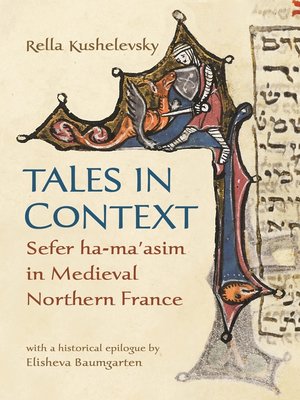Tales in Context
ebook ∣ Sefer Ha-Ma'asim in Medieval Northern France · Raphael Patai Series in Jewish Folklore and Anthropology
By Rella Kushelevsky

Sign up to save your library
With an OverDrive account, you can save your favorite libraries for at-a-glance information about availability. Find out more about OverDrive accounts.
Find this title in Libby, the library reading app by OverDrive.



Search for a digital library with this title
Title found at these libraries:
| Library Name | Distance |
|---|---|
| Loading... |
A folkloric research project on Sefer ha-ma'asim.
In the thirteenth century, an anonymous scribe compiled sixty-nine tales that becameSefer ha-ma'asim,the earliest compilation of Hebrew tales known to us in Western Europe.The author writes that the stories encompass "descriptions of herbs that cure leprosy, a fairy princess with golden tresses using magic charms to heal her lover's wounds and restore him to life; a fire-breathing dragon . . . a two-headed creature and a giant's daughter for whom the rind of a watermelon containing twelve spies is no more than a speck of dust." In Tales in Context: Sefer ha-ma'asim in Medieval Northern France, Rella Kushelevsky enlightens the stories' meanings and reflects the circumstances and environment for Jewish lives in medieval France. Although a selection of tales was previously published, this is the first publication of a Hebrew-English annotated edition in its entirety, revealing fresh insight.
The first part of Kushelevsky's work, "Cultural, Literary and Comparative Perspectives," presents the thesis that Sefer ha-ma'asim is a product of its time and place, and should therefore be studied within its literary and cultural surroundings, Jewish and vernacular, in northern France. An investigation of the scribe's techniques in reworking his Jewish and non-Jewish sources into a medieval discourse supports this claim. The second part of the manuscript consists of the tales themselves, in Hebrew and English translation, including brief comparative comments or citations. The third part, "An Analytical and Comparative Overview," offers an analysis of each tale as an individual unit, contextualized within its medieval framework and against the background of its parallels. Elisheva Baumgarten's epilogue adds social and historical background toSefer ha-ma'asim and discusses new ways in which it and other story compilations may be used by historians for an inquiry into the everyday life of medieval Jews.
The tales in Sefer ha-ma'asim will be of special value to scholars of folklore and medieval European history and literature, as well as those looking to enrich their studies and shelves.







